THE NYAE NYAE CONSERVANCY IN NAMIBIA—In a clearing here on the eastern fringe of the Kalahari Desert, four men intently examine animal tracks snaking through dry yellow grass and leafless thorn bushes. “Wild dogs. Six of them took down an impala 2 days ago and they dragged it,” says /Ui G/Aqo*, a master tracker and member of the Indigenous Ju/’hoansi group that has lived on these lands for millennia.
G≠kao Tsamkxao, an apprentice tracker, starts to measure the tracks with a ruler. Debe enters the measurements into a smartphone and snaps photos. After the trackers return to camp, they will upload the information to a database available to people around the world.
The September 2023 training exercise was, in part, an opportunity for Tsamkxao and a second apprentice, N!Ani /Ui, to make progress toward earning a certification as a master tracker—a specialist in the ancient art of recognizing and interpreting the tracks, gouges, scrapes, and other signs left behind by the region’s many animals. But it was also an experiment of sorts: an opportunity to field test CyberTracker Online, a new conservation data platform that aims to ease collaborations between Indigenous communities, scientists, and conservation managers. The goal is to empower almost anyone equipped with a smartphone—even people who can’t read or write—“to generate very rich and complex biodiversity data,” says Louis Liebenberg, founder of CyberTracker Conservation, the South Africa–based nonprofit that developed the platform and the tracker certification program.
Some 600,000 people in 150 nations have already downloaded older versions of CyberTracker, which Liebenberg started developing in the 1990s. Communities have used it to survey wildlife, monitor water resources, and map cultural sites. The tool has also helped conservationists manage vulnerable species and reserves and provided scientists with data used in numerous peer-reviewed publications on wildlife populations and behavior—including some co-authored by Indigenous trackers.
But the technology had limitations. Some users found navigating and customizing the software difficult, and they could lose valuable data if a smartphone or tablet got damaged or destroyed, a common hazard in fieldwork. So last year, Liebenberg began testing a new version that has a friendlier interface and uploads vulnerable field data to remote cloud storage instead of keeping it on a single device. The testing, done in partnership with Indigenous communities such as the Ju/’hoansi, is meant to ensure the technology meets local cultural and economic needs, preserves their knowledge, and promotes science.
Such partnerships are increasingly important, conservationists say, given growing evidence that the nearly 400 million people living in Indigenous communities around the world play a key role in managing landscapes and protecting biodiversity. “We’re talking about cocreating knowledge, codeveloping solutions, and CyberTracker allows you to do just that,” says Katarzyna Cieslik, a development specialist at the University of Manchester who has been studying the use of CyberTracker by communities in Kyrgyzstan. “Empowerment happens when the community actually takes charge.”
LAST YEAR’S RELEASE of CyberTracker marks the latest turn in Liebenberg’s eclectic and unusual career. The 64-year-old South African has no formal academic training in technology, development, or conservation—although in 2007 Harvard University named him an associate of human evolutionary biology. But growing up in Cape Town, he became fascinated by the San peoples of the Kalahari, renowned for their tracking skills. During childhood holidays at the beach, he recalls trying to track a friend’s footprints through the dunes.
![]()
Tracker /Ui /Kunta uses a smartphone loaded with CyberTracker Online software to record observations in the Nyae Nyae Conservancy in Namibia. MARCUS REYNERSON
In 1980, Liebenberg began to study physics and math at the University of Cape Town. While taking a course in the history and philosophy of science, he became fascinated by what he calls an “evolutionary paradox.” Scientific reasoning, he was taught, began with the ancient Greek philosophers. But how, he wondered, did humans evolve the ability to think scientifically if such reasoning wasn’t necessary for their survival earlier, as hunter-gatherers? Liebenberg dropped out of university to seek an answer. He was propelled, he says, by an “intuitive gut feeling” that tracking—which involves using observations to form hypotheses about animal behavior—helped lay the foundations of modern science. Over the next decade, he began to study and draw animal tracks, traveled to the central Kalahari in Botswana to study with !Nam!kabe Molote, a !Xõ master tracker, and spent long periods in the field with trackers as they hunted game.
Today, bows, arrows, and ostrich-shell necklaces from the Kalahari adorn the walls of Liebenberg’s home office in Noordhoek, a semirural suburb of Cape Town. He wears a necklace that holds the tip of the horn of a kudu killed during a “persistence hunt,” which involved chasing the animal for some 25 kilometers during the hottest part of the day until it collapsed from hyperthermia. Liebenberg says his foolhardy effort to follow that chase would have killed him, too, if a tracker named !Nate had not risked hyperthermia himself by running back to their camp for help. “He risked his life to save mine,” Liebenberg says.
The office is also stuffed with books, including some written by Liebenberg. Over the past 35 years, he’s produced three guides to tracking that describe animal habits and habitats and how to interpret tracks and spoor. And in 1990, Liebenberg published a volume, expanded and updated in 2013, that details his idea that tracking contributed to the beginnings of science. The reasoning process required to track an animal helps “explain how the human mind evolved the innate ability to do science,” he wrote. “It is easy to see how natural selection” would have favored people with tracking skills, he adds.
While living with the Kalahari San, however, Liebenberg learned tracking was a dying skill. Game populations had diminished; Indigenous trackers could no longer survive by hunting and needed jobs. At the time, just one veteran tracker remained and young people were showing little interest in learning the skill. At that point, “My whole research pivoted,” Liebenberg recalls, to figuring out how he could help preserve tracking skills and use them to benefit trackers, their communities—and scientists.
South Africa’s transition to democracy in the 1990s gave Liebenberg an opportunity. He helped produce a report on how national parks could benefit nearby communities that informed policies adopted by the postapartheid government of former President Nelson Mandela. In 1994, Liebenberg built on that work by launching a program that trains people in tracking and offers a certification aimed at helping them find jobs in tourism and conservation. Since then, some 10,000 people have completed the training.
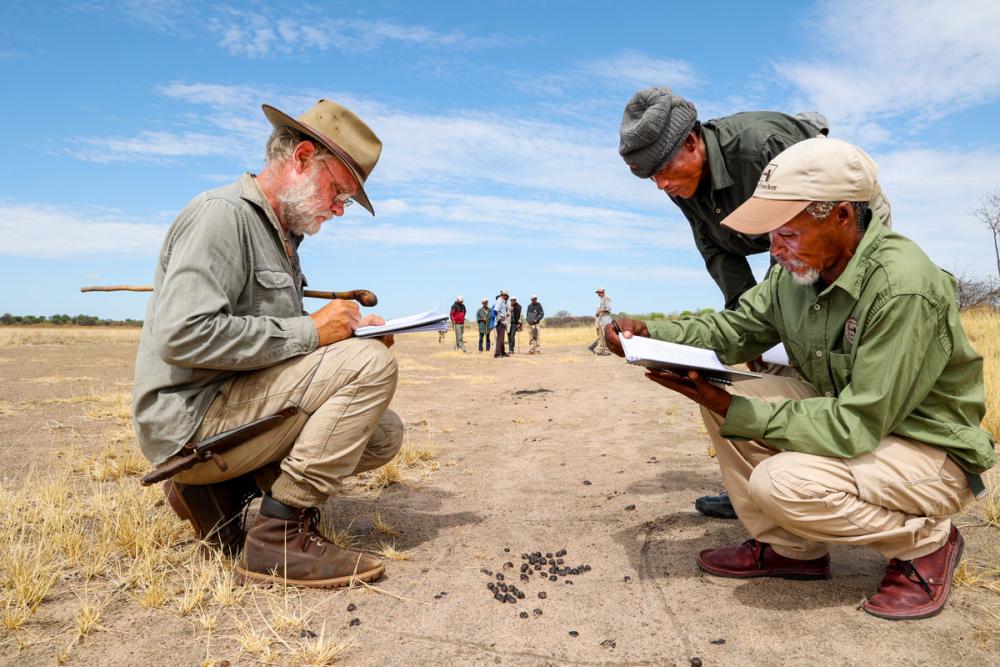
Dam Debe (far right) coordinates a program developed by Louis Liebenberg (left) that trains people in how to interpret tracks left by animals and enter observations in the CyberTracker Online software. MARCUS REYNERSON
At about the same time, Liebenberg began to work with trackers to develop the first version of CyberTracker. From the beginning, the idea was to create an intuitive, icon-based interface that would enable nonliterate users to collect detailed data on GPS devices. When in the field, for example, the user could select an icon in the shape of a track to identify the kind of animal—whether it was made by a hoofed creature, one with padded feet, a bird, or a reptile. Then, users could input the number of animals; differentiate between males, females, and juveniles; and add the kind of habitat, such as dry grassland or wet forest. GPS links enabled the software to record the location of each observation, easing the task of making maps and analyzing the data.
An early field test came in 1996, when Karel Benadie, an Indigenous tracker collaborating with Liebenberg, and a colleague used CyberTracker to record the behavior of endangered black rhinoceros in South Africa’s Karoo National Park; the data were later published in Pachyderm. Two years later, CyberTracker got a boost when it won a prestigious Rolex Award for Enterprise, which came with a $50,000 prize and, more importantly, publicity. The recognition enabled Liebenberg to raise additional funds, including a €2 million grant from the European Union to improve CyberTracker and make it free to all. The aim, Liebenberg says, was to “not only democratize science itself, but to also make it affordable.”
USERS SOON FLOCKED to CyberTracker. One of the earliest adopters was South Africa’s national park system. In the 2-million-hectare Kruger National Park, for example, 400 rangers now use the app to record a wide range of observations, including data on biodiversity, invasive species, surface water availability, breaks in fence lines, and evidence of poachers (such as human footprints).
“I take CyberTracker along with me when I go out for anything,” says Richard Sowry, a Kruger section ranger who manages a 15-person team that monitors some 100,000 hectares of the park. Sowry has used CyberTracker since 2006, making him the park’s longest running user. Rangers once recorded information in logbooks, he says, where it often “went into the abyss.” In contrast, he says, CyberTracker’s digital data sets are easy to share and make it possible for conservation managers to see patterns and work more strategically. For example, Sowry was able to better plan antipoaching patrols after CyberTracker data showed illegal hunting surged in the dry season. He says managers also use CyberTracker data to demonstrate the park’s value to local communities and funding agencies, for example as a source of culturally important resources such as the leaves of the lala palm, used to make mats and baskets.
![]()
![]()
CyberTracker Online software (left) uses icons to make it easier for nonliterate users to enter data about observations, such as sightings of elephant tracks (right). DIMITRI SELIBAS
CyberTracker also won admirers in the public health community after it helped provide an early warning of Ebola outbreaks in Gabon and the Republic of Congo. Twice, wildlife researchers were able to alert health authorities that Ebola was likely spreading after CyberTracker data showed a “significant drop” in populations of gorillas, chimpanzees, wild pigs, and other animals also affected by the virus, researchers reported in 2016 in Biological Conservation. (The authors of that paper included Liebenberg and two trackers.)
In Kyrgyzstan, Cieslik says communities have “loved” using CyberTracker for conservation efforts, with residents creating maps of “things they saw, including fungi, plants, and heritage sites, which were displayed in the villages.” Ironically, some communities also wanted to use the tool to help track and kill wolves that threatened livestock. But Cieslik says that twist actually highlights one of the technology’s advantages: its flexibility. “People can adapt it to their needs in the present moment,” she says.
In Australia, CyberTracker has been adopted by many Indigenous ranger and community groups, as well as local governments and academic researchers, says ecologist Emilie Ens, who leads the Cross-Cultural Ecology and Environmental Management Lab at Macquarie University. Since 2010, she and her colleagues have published 12 papers that cite CyberTracker data on topics including how feral buffalo and pigs are affecting wetlands and the habits of wildlife in remote parts of Australia.
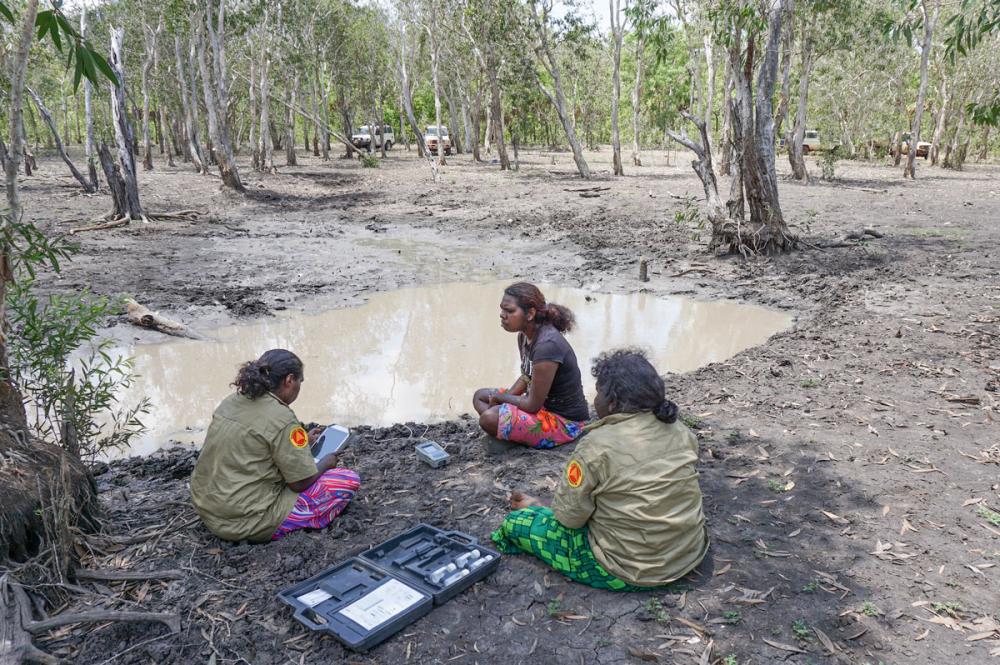
In northern Australia, Yirralka Rangers (from left) Sarah Gurrundul Marawili, Rena Djarrka Wanambi, and Kathy Djurrayun Murrunyina use CyberTracker Online to record water quality measurements and other data. EMILIE ENS
As CyberTracker grew in popularity, however, so did a wish list of possible improvements. Users often needed outside technical assistance, for example, if they wanted to customize the interface or synchronize devices used in the field with other computers. And the data were vulnerable. “If the tablet falls into a creek … gets stomped on by a buffalo, you lose the data,” Ens says.
To address such problems, nearly a decade ago Liebenberg began to plan improvements, including making the interface even more accessible to people who aren’t literate. It’s not just about selecting icons that are easy to interpret, Liebenberg says. “It’s understanding the underlying flow from screen to screen,” and enabling it to better reflect the information-gathering sequence used by trackers in the field.
After some delays, in April 2023 CyberTracker was finally ready for wide testing. To give it a real-world workout, Liebenberg turned to the Ju/’hoansi trackers.
DURING THE SEPTEMBER 2023 training exercise the trackers didn’t just test the software. Because they were in the only part of the Kalahari where bow-and-arrow hunting is still allowed, the men had also come prepared to hunt big game. When the team spotted a group of blue wildebeest in a clump of trees, N!Ani /Ui, the apprentice tracker, pulled from his quiver an arrow tipped with a deadly poison extracted from beetle larvae. He stayed low and downwind as he stalked the herd. But his shot went wide and the wildebeest scattered.
The testing went better. The trackers plugged in data on a herd of roan antelope, then a single male cheetah. In a sandy area, they spotted giant oval impressions with intricate, treelike lines—indications a large herd of elephants had moved through, 22 to be exact, mostly females and babies. The trackers also found signs of eland (a type of antelope), ostrich, aardwolf, bat-eared foxes, and other animals.
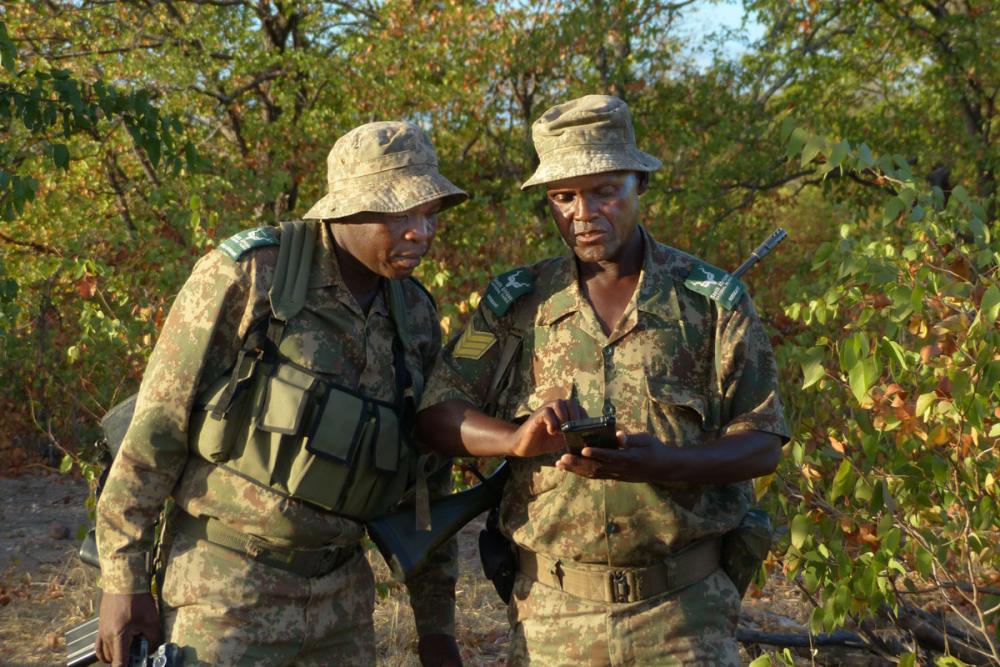
In South Africa’s Kruger National Park, field rangers use CyberTracker Online to monitor wildlife and support efforts to deter poaching. RICHARD SOWRY
Overall, the software worked smoothly, enabling the trackers to work efficiently as they moved across the landscape. By midday, it was too hot to continue tracking and the team returned to camp. In this remote corner of Namibia, successfully uploading the data required the trackers to climb a wooden ladder leaning on a thatch hut and stretch their arms to raise the phone as high as possible to gain a signal.
Later, in Liebenberg’s office, a digital map displayed an array of colorful dots, indicating the species spotted by the Ju/’hoansi within a roughly 10-kilometer-square area. By combining those data with other information, such as how much time the trackers spent in the field and the distance they walked, researchers and the Ju/’hoansi should be able to estimate the overall abundance of specific species—and, over time, track how populations are changing.
Enabling local people to document such trends could help Liebenberg realize one of his long-term goals: using CyberTracker to help Indigenous communities earn revenue. Australia, for example, last year adopted legislation that could enable communities to collect payments for protecting forests and wildlife, and CyberTracker data could play a key role in such programs. In Africa, the software is already easing the ability of trackers to get paid: For example, Debe, the Kalahari tracker, uses it to upload invoices for monitoring projects and tracking schools.
Farmers, too, could become important users of CyberTracker. Liebenberg has been surprised to discover, for example, that farmers in Colombia are downloading the app. One recorded more than 30,000 observations related to crop pollination. That raises the possibility, Liebenberg says, that some farmers might be willing to pay a small fee for customized features, helping keep the app free for other users.
In the meantime, the Ju/’hoansi trackers say their decadeslong involvement with Liebenberg and CyberTracker has produced results. Tracker /Ukxa Qam says the app has prompted many to learn to identify and pay greater attention to nongame animals, including rare and endangered species such as the pangolin. Six Ju/’hoansi have become master trackers, with an additional eight trackers in the process of qualifying. Some have become co-authors on scientific papers.
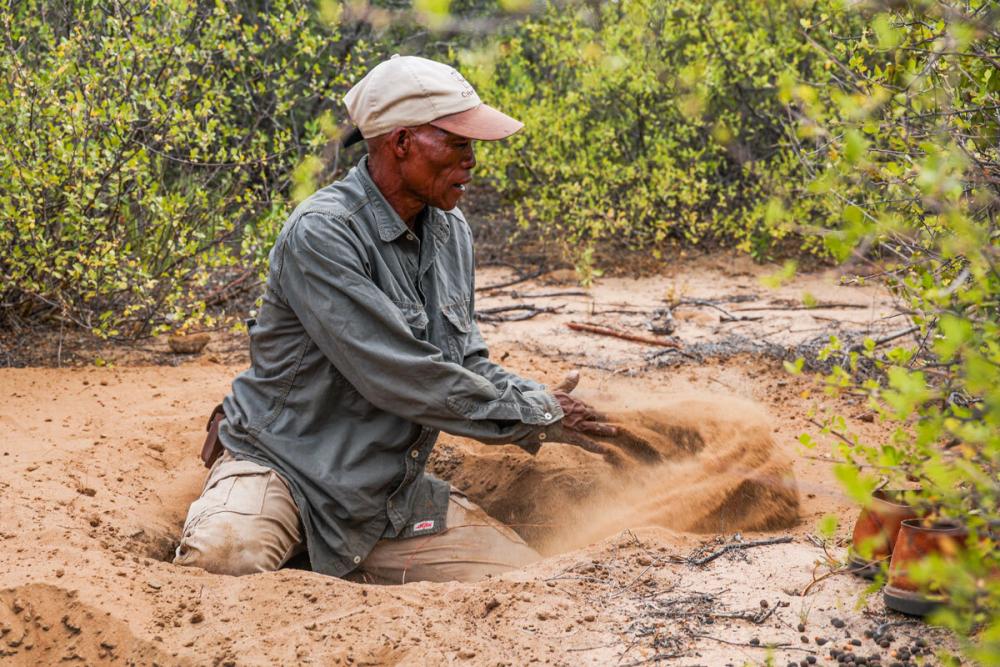
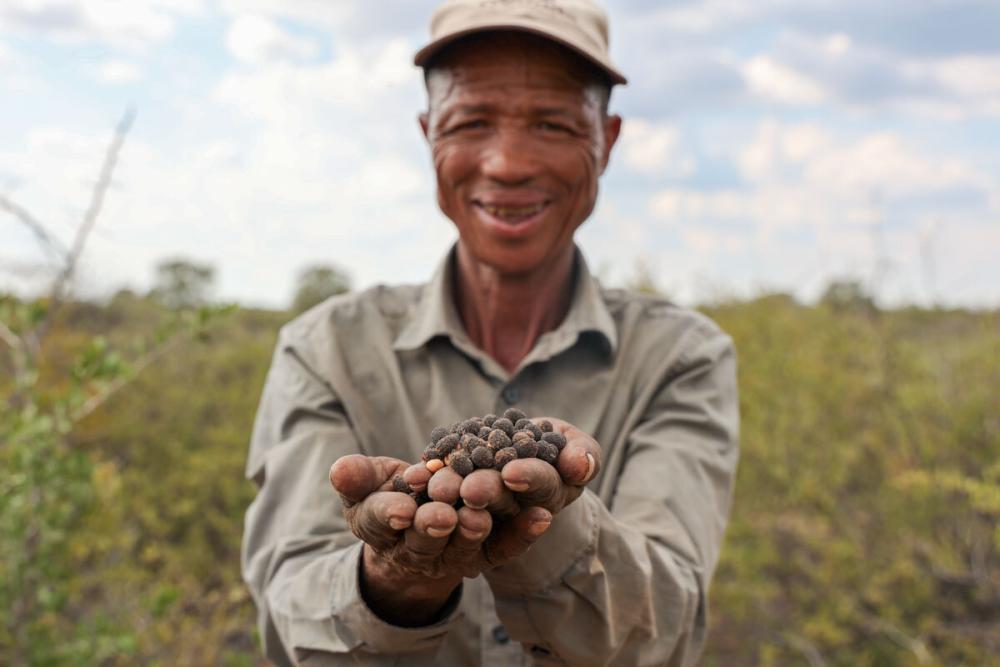
Tracker /Ui G/aqo (left) digs up beetle larvae used to create a poison placed on the tips of hunting arrows. Tracker /Ui /Kunta (right) shows off a haul of larvae. MARCUS REYNERSON
For his part, Liebenberg sees devices loaded with CyberTracker as a way to help draw a younger generation that grew up with smartphones into observing the natural world. The Ju/’hoansi, he notes, have a long tradition of adapting new technologies to their needs, from fashioning arrow tips out of fence wire to using plastic pipes as quivers to keep poison arrows dry during the wet season. Using a smartphone during tracking is no different, he says.
At the end of the day, the trackers who tested the technology seemed to agree. Gathered around a fire as elephants trumpeted at a nearby watering hole, some of the trackers watched movies or played video games on smartphones as they heated water for tea. Thanks to CyberTracker, /Ukxa Qam said, “People are seeing our culture,” and learning from it, too.
Dimitri Selibas is a writer in Cape Town, South Africa.
Science Magazine.
Support nonprofit science journalism
Help Science publish trustworthy, high-impact stories about research and the people who shape it. Subscribe to News from Science.
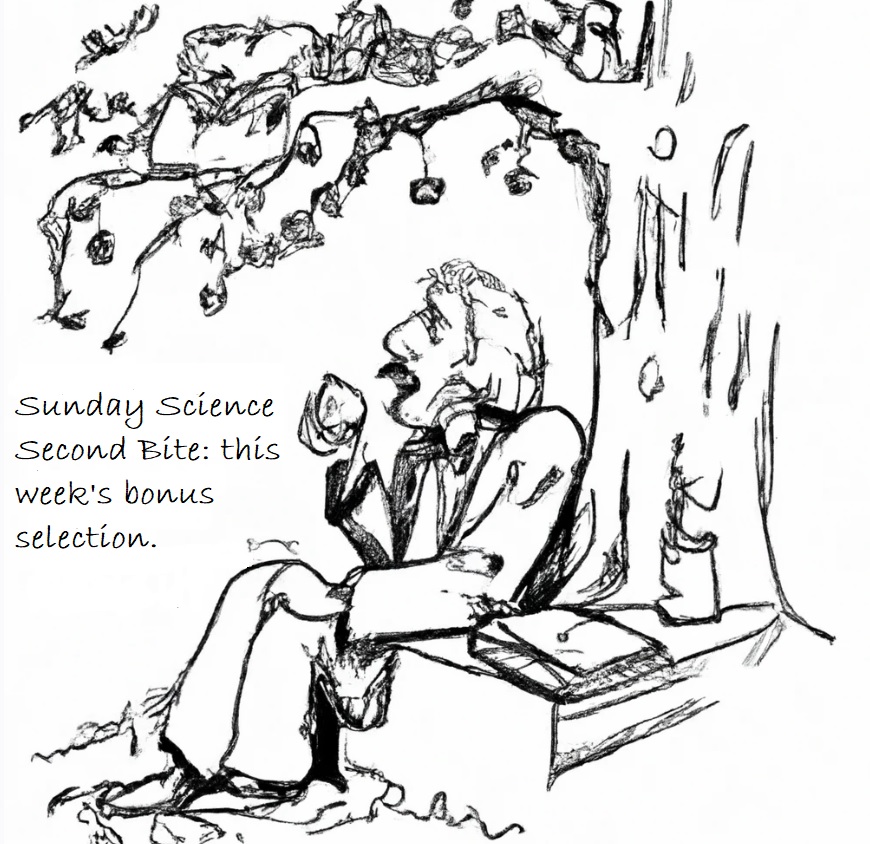
The West Has a 15-month Opportunity for a New Nuclear Deal with Iran That Precludes an Iranian Bomb
By Seyed Hossein Mousavian
Bulletin of the Atomic Scientists
June 11, 2024

Spread the word